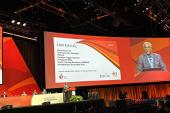Inclisiran Plus Usual Care Improves LDL Control in ACS: VICTORION-INCEPTION
(UPDATED) Nearly two-thirds of patients reached < 70 mg/dL with the small interfering RNA therapy.

The rapid addition of small interfering RNA therapy to usual care after a recent ACS helps more patients achieve recommended LDL-cholesterol targets than does usual care alone, data from the VICTORION-INCEPTION study show.
At 1 year, two-thirds of patients treated with inclisiran (Leqvio; Novartis) on top of statin and nonstatin lipid-lowering therapies achieved an LDL target of less than 70 mg/dL compared with just 28.1% of those receiving usual care alone (P < 0.001).
“Inclisiran made a huge difference,” lead investigator Kirk Knowlton, MD (University of Utah/Intermountain Health, Salt Lake City, UT), told TCTMD. “It seems like it could have a major beneficial effect in treating these patients who did not reach the [LDL-cholesterol] goal by their first visit after the hospitalization, and this could be a strategy to help them get there right away.”
The most recent ACS guidelines, published in February 2025 on behalf of the American College of Cardiology and the American Heart Association in collaboration with other societies, make a recommendation for maximally tolerated statins for all patients. For ACS patients on maximally tolerated statin therapy with LDL levels of 70 mg/dL or higher, use of another lipid-lowering agent is a class 1 recommendation (level of evidence A) to further reduce the risk of MACE. Combination therapy is also considered reasonable if LDL-cholesterol levels are between 55 mg/dL and less than 70 mg/dL (class 2a, level of evidence B).
“I think it's been a big challenge to get physicians in the healthcare system to think really aggressively about lowering the LDL cholesterol in this high-risk population,” said Knowlton. For example, data from their healthcare system showed that a large percentage of patients aren’t even having their LDL cholesterol measured after an atherosclerotic cardiovascular disease (ASCVD) event.
Today, there are numerous nonstatin therapies including inclisiran, ezetimibe, alirocumab (Praluent; Sanofi/Regeneron), evolocumab (Repatha; Amgen), and bempedoic acid (Nexletol; Esperion).
Nearly 50% Further Reduction
The VICTORION-INCEPTION study, which was presented at the National Lipid Association Scientific Sessions last week, included 400 patients (median age 60.5 years; 29.0% female) with ACS and randomized them to treatment with usual care plus inclisiran or only usual care, which was defined as the use of statin and/or nonstatin therapy considered appropriate by treating physicians.
All patients had an index ACS hospitalization 5 weeks or less before randomization (median 34 days) and LDL-cholesterol levels of 70 mg/dL or greater. Roughly 65% of patients were on a lipid-lowering therapy at the time of hospitalization for ACS. Inclisiran was administered by injection at baseline, 90 days, and 270 days.
“These are high-risk patients who’ve just had a heart attack,” said Knowlton. “Historically, in 2013 when they released the guidelines, they just said to put them on a high-intensity statin. That was the main thing you needed to do because that was all they had options for at the time. There weren’t a lot of other good opportunities [for lowering LDL and reducing risk].”
At baseline, the median LDL level was 84.0 mg/dL. By day 330, LDL cholesterol had declined by 45.6% in those randomized to inclisiran plus usual care whereas there was an increase of 1.4% among those treated with usual care alone (mean difference 46.9%; P < 0.001). More than 54% of inclisiran patients achieved an LDL-cholesterol target of < 55 mg/dL, as compared with 13.6% in the usual care group.
Regarding the relatively high number of patients already on lipid-lowering therapy at the time of hospitalization, Knowlton said that nearly one-quarter had a prior MI while nearly 7% had peripheral vascular disease, which may explain why it exceeds what has been observed in other ACS studies.
Christopher Cannon, MD (Brigham and Women’s Hospital, Boston, MA), who wasn’t involved in the study, said the concept of rapidly adding inclisiran after ACS is a sound one, the goal being to get control of LDL cholesterol early. The EVOPACS study, published in 2019, showed that adding evolocumab to a high-intensity statin in the hospital setting was safe and resulted in a large percentage of patients hitting recommended LDL treatment targets, said Cannon.
“With our current reimbursement scheme, most insurers require ‘failing maximally tolerated statin and ezetimibe [or] not being at goal’ to reimburse a PCSK9, so we would currently only think about ezetimibe, as the ACS guidelines propose,” he told TCTMD.
To move the needle with insurers, trials showing an improvement in clinical outcomes when these second-line therapies are added early, or in-hospital, would be necessary, said Cannon. To that end, there is the ongoing EVOLVE-MI study investigating whether adding evolocumab to high-intensity statin therapy within 10 days of ACS reduces the risk of all-cause mortality, MI, ischemic stroke, or revascularization. Another trial, AMUNDSEN, is investigating the use of evolocumab given before PCI in STEMI patients or within 3 days of hospitalization for NSTEMI, but that study is only looking at changes in LDL cholesterol.
Adding Ezetimibe in Hospital?
Kausik Ray, MD (Imperial College London, England), and Julia Brandts, MD (University Hospital Aachen, Germany), in a commentary published by the Journal of the American College of Cardiology in conjunction with the new ACS guidelines, argue the document missed an opportunity to be more aggressive in the hospital setting. While ACS patients typically are started on high-intensity statins in the hospital, adding ezetimibe is only a class 2b recommendation despite data from IMPROVE-IT showing its addition to statin therapy lowers the risk of major adverse cardiovascular events.
Also, waiting 4 to 8 weeks after hospital discharge to intensify lipid-lowering therapy exposes patients to a higher risk of recurrent events in a vulnerable period and raises questions about the feasibility of the approach in the real world, according to Ray and Brandts. Data suggest that fewer than one in three high-risk patients receive appropriate further treatment beyond the statin, they say, and for this reason, physicians should really be discharging all patients with an ACS on combination therapy with a high-intensity statin and ezetimibe.
In an analysis of the SWEDEHEART registry, Ray, along with lead researcher Margrét Leósdóttir, MD, PhD (Lund University/Skåne University Hospital, Malmö, Sweden), recently showed that combination therapy with ezetimibe and a statin given early after MI translates into a lower risk of recurrent events when compared with patients who started combination therapy late or not at all.
To TCTMD, Ray said in an email that there are challenges with using inclisiran, as well as the PCSK9 monoclonal antibodies and bempedoic acid, as the first add-on to statin therapy in ACS, among them cost. Ezetimibe is available as a generic medication, while these other drugs remain on patent and are expensive. Like Cannon, he cited other considerations such as regional variations in reimbursement and difficulties with adhering to treatments than involve injections.
For Ray, these other lipid-lowering therapies would be third-in-line after high-intensity statin therapy and ezetimibe in high-risk subgroups, such as those with still-elevated LDL cholesterol or lipoprotein(a).
In terms of where inclisiran fits into the treatment landscape, Knowlton said the dosing schedule has advantages for some patients who don’t mind injections.
“It would be difficult to say that everyone who comes into the office with an LDL greater than 70 should have inclisiran added,” he said. “I don’t think that's what this [study] would imply, but you have to consider all the different factors. Ezetimibe usually lowers [LDL cholesterol] a little bit more, but it's not going to have that 48% or 49% reduction that inclisiran has. If we get [positive] outcomes data from ORION-4, then I think that will make a very strong case to consider using inclisiran as a second-line agent.”
The ongoing ORION-4 study is comparing inclisiran to placebo in 16,000 patients with ASCVD, with the primary endpoint being coronary heart disease death, MI, stroke, or urgent revascularization at 5 years. Enrollment is completed, and results are expected in late 2026 or early 2027.
Michael O’Riordan is the Managing Editor for TCTMD. He completed his undergraduate degrees at Queen’s University in Kingston, ON, and…
Read Full BioSources
Knowlton KU, Navar AM, Anderson JL, et al. LDL-C management with inclisiran plus usual care vs usual care alone in participants with recent acute coronary syndrome: VICTORION-INCEPTION. Presented at: NLA 2025. Miami, FL.
Disclosures
- VICTORION-INCEPTION was funded by Novartis.
- Knowlton reports being an investigator on other Novartis-sponsored trials.





Comments